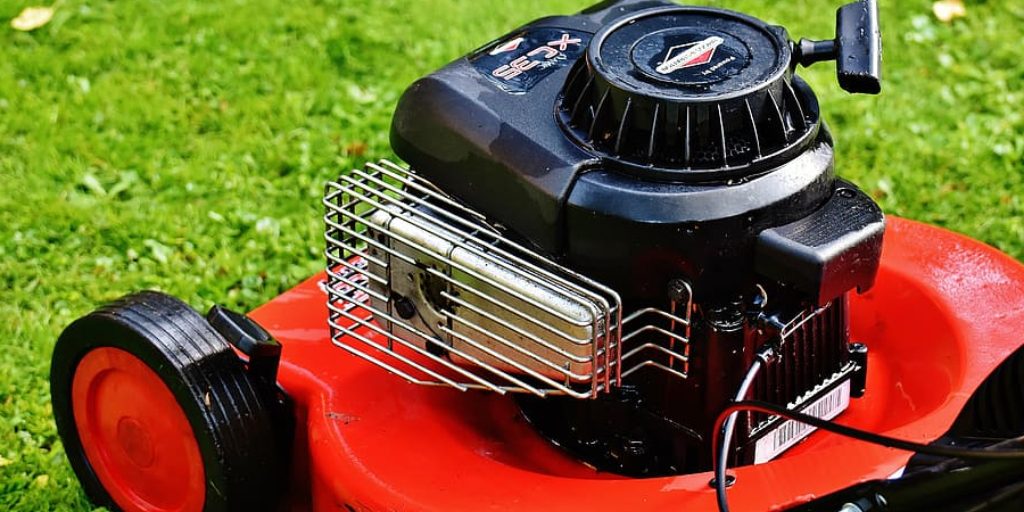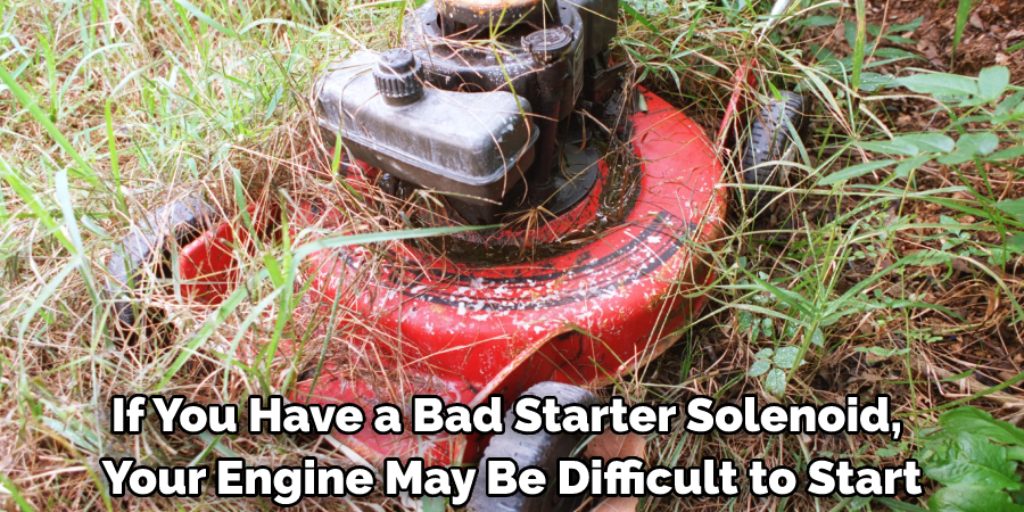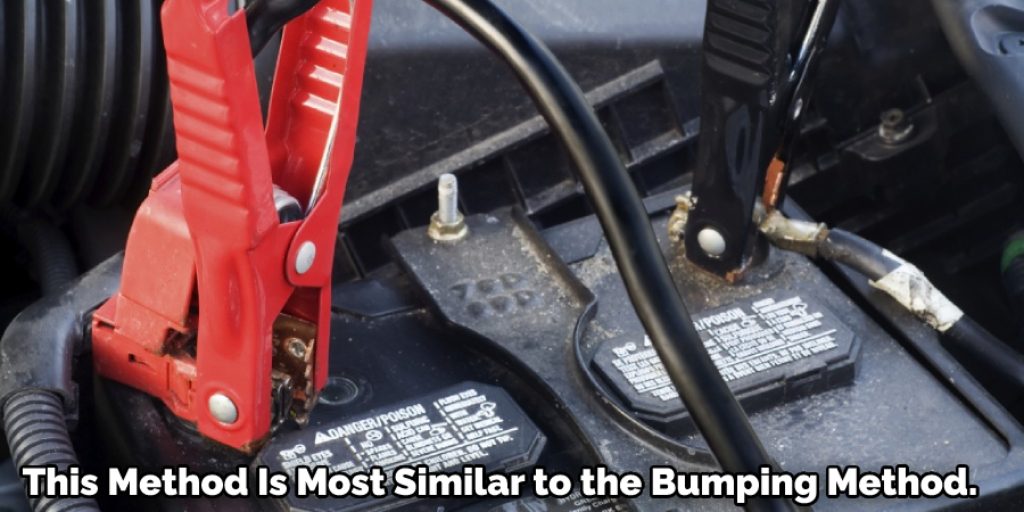How to Start a Lawn Mower Without a Starter
Starting a lawnmower without the starter can be as simple as pulling on the cord or as complicated as fiddling with the engine.
A common way to start a lawnmower is by pulling on the cord, but some people prefer to use their feet and push down on an accelerator pedal. Unfortunately, this will cause it to turn over and start.
If your lawnmower starts with pull-starting, adjusting your choke may solve any problems you’re experiencing getting it started; this function regulates how much air enters into the carburetor during starting for easier starting.
Finally, if none of these methods work for you, you might want to check out our article on how to start a lawn mower without a starter containing more detailed information.

Reasons Why Your Lawn Mower Won’t Start:
1. Faulty Battery:
Make sure the battery is fully charged. A low or weak battery won’t start your mower; in fact, it may not even make a sound when you turn the key.
2. Loose Cable:
The cables and clamps that connect your battery to your starter and electrical system need to be examined to make sure they are secure and in good working order.
3. Old Spark Plug:
Even though you may have just replaced it last spring, a spark plug that’s been sitting for a year will be corroded and useless. Make sure your spark plug is clean and adjusted correctly to ensure a strong spark.
4. Faulty Magneto Coil:
A faulty magneto coil can also prevent your lawnmower from starting. Check the condition of the wires and insulation on the coil to make sure everything is in good working order. Also, check that all connections and clamps are in place and secure.
5. Bad Fuel:
If you run out of fuel, try adding a fresh supply of gasoline to your lawnmower. Old gas is the worst culprit for not starting a mower since it can clog up the carburetor and fuel lines.
6. Dirty Air Filter:
A dirty air filter can cause problems with your lawnmower’s engine performance or prevent it from starting at all. This is because a dirty air filter reduces the amount of air available to the engine, making it more difficult for it to start.
7. Dirty Spark Arrestor:
Your engine may not start if the spark arrestor, located under some models’ muffler is clogged. A dirty spark arrestor can cause problems with your lawnmower’s engine performance or prevent it from starting at all.
8. Faulty Ignition Switch:
The electrical switch that supplies power to your starter could be faulty, preventing it from sending the spark to the spark plug.
If you suspect there’s a problem with your ignition switch, check both ends of the key for power; if one end doesn’t have power and the other does, it indicates a problem with your ignition switch.
9. Bad Starter Solenoid or Motor:

If you have a bad starter solenoid, your engine may be difficult to start. On some models, checking this component is as easy as disconnecting the wires and taking off the housing to inspect if it’s burned out. If you suspect it’s beyond repair, replace it.
10. Bad Alternator:
Your lawn mower starts but dies a minute later, indicating a faulty alternator. Likewise, if your battery is working and fully charged but can’t stay alive to start your engine, you may have a bad alternator.
If you run into any one of these problems, don’t despair! In most cases, you can fix the problem yourself or have a mechanic diagnose and repair your lawnmower. Follow the methods below to know how to start a lawn mower without a starter.
10 Methods on How to Start a Lawn Mower Without a Starter:
1. Priming Method:
Priming is a method in which you manually pump the fuel from the tank to the carburetor. You can prime the mower by sitting or kneeling on the ground behind it. Turn off the blades and turn off the fuel supply to prevent injury.
It is best to have someone standing by if anything goes wrong with your priming process. If you are alone, keep an eye on the mower, just in case. Turn the fuel supply on (open it up all the way) and pull out the choke knob located beneath or to the side of the engine.
2. Rocket Method:
The rocket method is done with a spare mower where you have removed its starter. Typically, one would use a lawnmower blade sharpening tool to remove the starter.
If you are unfamiliar, online tutorials are available on how to do this safely. You then cut a hole in the side of your mower’s gas tank. Put the end of your spare lawnmower into that hole and press the blades against an object at ground level, similar to priming the mower.
3. Bump Method:
The bumping method is done by putting the lawnmower blade sharpening tool back in place on your lawnmower and positioning yourself at the side of the mower with all the controls, including the fuel supply line and choke knob.
You then bump it while holding down the transmission bar (not the blade sharpening tool) to turn it over.
4. Cutting a Lawn Mower’s Starter Wire:
This method is considered the most dangerous because it involves cutting your lawnmower. Make sure you have read all of the safety precautions and are fully aware of what you are doing. To do this, turn off the gas supply to prevent injury or mishap with your mower.
Then use your lawn mower blade sharpening tool to cut the starter wire. See where this wire is on your mower, as it differs depending on the model. With a little time and patience, you can locate it. Be careful not to cut any other wires by accident during the process.
5. Lawnmower Blade Sharpening Tool:
If you don’t have a lawnmower blade sharpening tool, you could purchase one. If you know someone who owns a mower with a starter, ask them if you can borrow their lawnmower blade sharpening tool.
6. Pulling With Another Lawn Mower:
You can use a spare mower to pull-start your own. However, you will need a second person to help lift the dead mower and hold it in place while someone else is attempting to pull-start it from behind.
7. Using a Jumper Cable to Start:

This method is most similar to the bumping method. However, instead of using your lawnmower blade sharpening tool, you use jumper cables with another vehicle to help start your mower. This only works if the other car has a good battery and is charged up all the way. Also, remember that this will drain the other car’s battery.
8. Pulling With a Tree Branch:
You can use a fallen tree branch or limb to help start your mower. You will have to use the lawnmower blade sharpening tool to remove the starter from your mower. Then move your lawnmower to a flat surface with enough space for it to be absolutely still while you try to pull-start it.
Make sure there are no other items that could get in the way of pulling. Next, you can use your lawnmower blade sharpening tool to attach it to the near end of the fallen tree branch, which should be straight and sturdy enough for your needs. Then slowly pull back while trying to turn over your mower with your other hand.
9. Using a Screwdriver:
You can use a screwdriver to help start your lawnmower, although this method is only recommended in emergencies. You will need to attach the screwdriver’s flat head to the starter’s bottom end and lift it at an angle so that when you pull on it with some strength, it begins to make solid contact with your mower’s engine.
10. Using a Battery:
Using another battery to start your mower may sound like an easy method, but it can cause damage if you do not know what you are doing, and the chances of injury and fire hazards increase drastically.
However, there is a way to protect yourself and use this method safely: remove any metal objects from your body, such as rings, watches, and bracelets. Use rubber gloves to protect your hands, and wear protective glasses to shield your eyes.
Note: If you don’t have a lawnmower blade sharpening tool or another battery, you won’t be able to do this method safely.
Although the chances of injury increase by using other batteries, it can still be done by using electrical tape to attach both batteries so they are constantly in contact. Be sure to do this away from flammable objects, your home or garage, etc.
Precautions and Warnings:
1. Never use a metal screwdriver to start a lawnmower.
2. Make sure the area around the mower is clear before starting it.
3. Turn the unengaged blade off and set the parking brake on the machine when you are done. This will help prevent accidental injury from moving blades. If this happens, be sure to follow proper procedures for removing an injured person from a lawnmower.
4. Never try to start a lawnmower with the blade engaged. If the machine starts without you anticipating it, you may lose control and end up hurting yourself or others.
5. Do not allow children to be near lawnmowers at any time unless they are being supervised.
6. Always wear shoes when you are operating a lawnmower. Flip-flops or sandals can be easily caught in the blades, pulling your feet in and causing serious injury.
7. If you haven’t used a lawnmower in a while, be sure to give it a once-over before firing it up. Check the fuel lines, blade, and engine for any cracks or damage.
8. Make sure the area around the lawnmower is clear of debris like rocks or toys that could cause damage to the blades or get caught in moving parts.
9. Always wear eye protection when using a lawnmower. This will help protect your eyes from flying debris as well as the blades of the mower.
10. If you have not used a lawnmower in some time, check to ensure it has enough oil and fuel before starting it. Then, fill up or replace them if needed to ensure a properly working machine for safety reasons.
How Do You Check a Starter on a Riding Lawn Mower?
You may be surprised to learn that a riding lawn mower has a starter similar to one in your car. A riding lawn mower starter consists of an electric motor and a set of solenoids. If everything is up to date with the wiring, the problem is likely an electrical connection or worn solenoids that can be repaired or replaced.
1. Make sure the start switch is turned on, and the key is inserted.
2. If you have a lawnmower with an electric starter, ensure that the solenoids get power by separating the wire clip to expose the wiring.
3. Review any fuses or circuit breakers on the mower. If they are not working, you will need to replace them before continuing.
4. Check solenoids for any visible signs of corrosion or damage. If they are worn, replacing them is an option that most lawn mower repair shops can easily handle.
5. Make sure that all wires are connected properly. If they have been damaged, replace them if possible. Then attach the wire clip to secure them in place.
6. Make sure there are no dirt or grass clippings inside the solenoids before you try starting the mower again.
7. Test your lawnmower after completing repairs to ensure it is working properly.
If you can’t fix the starter yourself, try the above methods mentioned in this blog post on how to start a lawn mower without a starter. You will definitely find a way to start your machine again.
Final Words:
As you can see, starting a lawnmower without the starter is possible. While this may not be the most common issue people come across when starting their yard equipment, there are some situations where it might be necessary to get out of an emergency and find another way to start your machine.
Hopefully, now that we’ve shown you how to start a lawn mower without a starter with these tips, you’ll never have any trouble again! Let us know if you still find any difficulty with starting your lawnmower.




